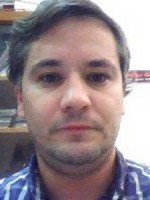resumo
The present work reports the first attempt of thermoelectric module design, based on oxide materials grown through the laser floating zone technique. Two modules with 4-legs thermoelectric were assembled using Bi(2)Ba(2)Co(2)Oy fibres as p-type legs, while Ca0.9La0.1MnO3 and CaMn0.95Nb0.05O3 fibres were used as n-type legs. Structural and electrical characterisation of the individual fibres was performed, and the results compared to the literature. The evolution of open-circuit voltage on heating and cooling up to 723 K, present the expected trends based on the Seebeck coefficient of the individual fibres, suggesting good reliability of the modules during temperature cycling. The power generation performance was evaluated for a temperature difference up to 500 K under different electric loads. The maximum measured power was similar to 2.2 mW for a module volume of similar to 39 mm(3). Nevertheless, the module here studies possess better performance than those commercially available.
palavras-chave
POWER-GENERATION; TEST SYSTEM; OXIDE; PERFORMANCE; FABRICATION; MANGANITE
categoria
Materials Science
autores
Ferreira, NM; Lopes, D; Kovalevsky, AV; Costa, FM; Sotelo, A; Madre, MA; Rezania, A
nossos autores
Grupos
agradecimentos
The authors gratefully acknowledge the support of i3N (UIDB/50025/2020 & UIDP/50025/2020), CICECO - Aveiro Institute of Materials (UID/CTM/50011/2020) and the REMOTE project (POCI-010145-FEDER-031875), financed by COMPETE 2020 Program (Portugal), National Funds through the FCT/MEC (Portugal) and when appropriate co-financed by FEDER under the Portugal2020 Partnership Agreement. This work was also funded by national funds (OE-Portugal), through FCT - Fundacao para a Ciencia e a Tecnologia, I.P., in the scope of the framework contract foreseen in the numbers 4, 5 and 6 of the article 23, of the Decree-Law 57/2016, of August 29, changed by Law 57/2017, of July 19.; NM Ferreira also acknowledges the grant support from ECIU Research Mobility Fund 2019 edition that allows the visit to Aalborg University to conduct the present study.; A. Sotelo and M. A. Madre acknowledge MINECO-FEDER (MAT2017-82183-C3-1-R) and Gobierno de Aragon (Spain) - FEDER (Research Group T54-17R) for financial support.


